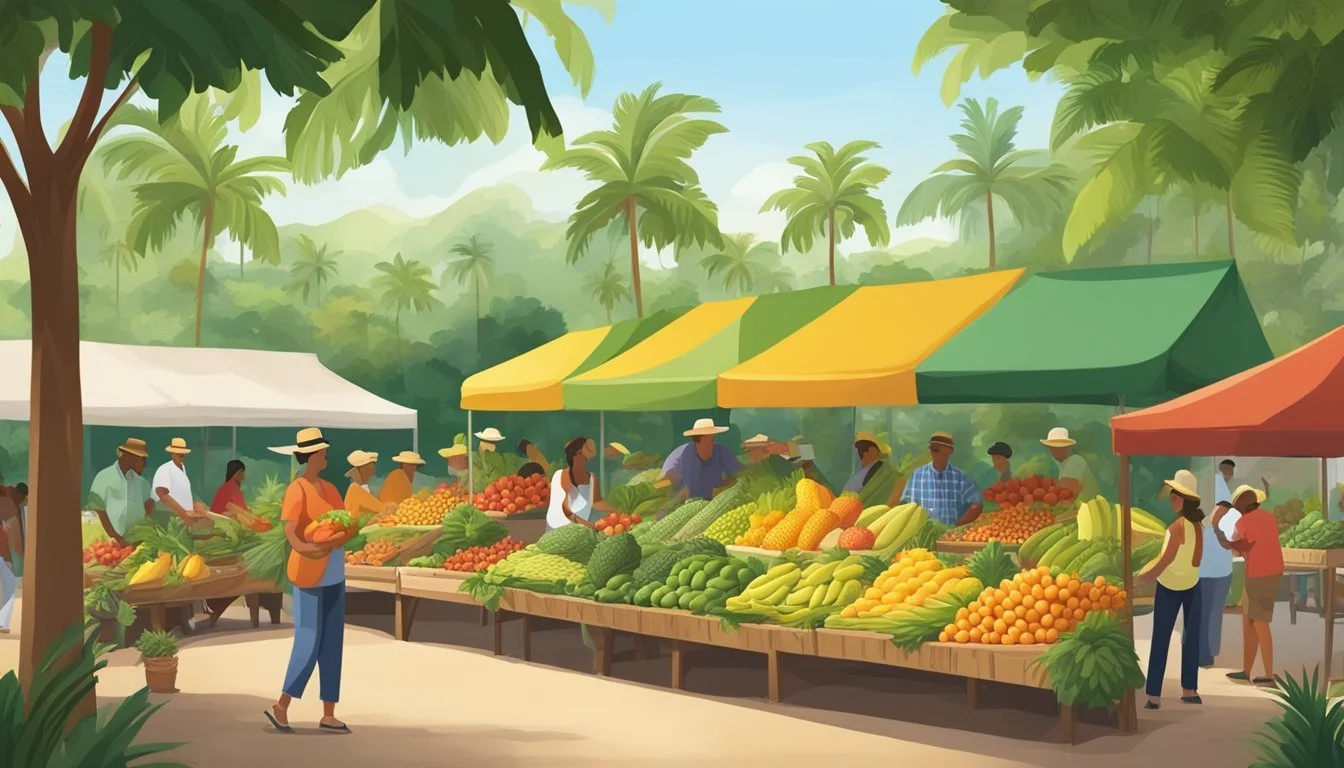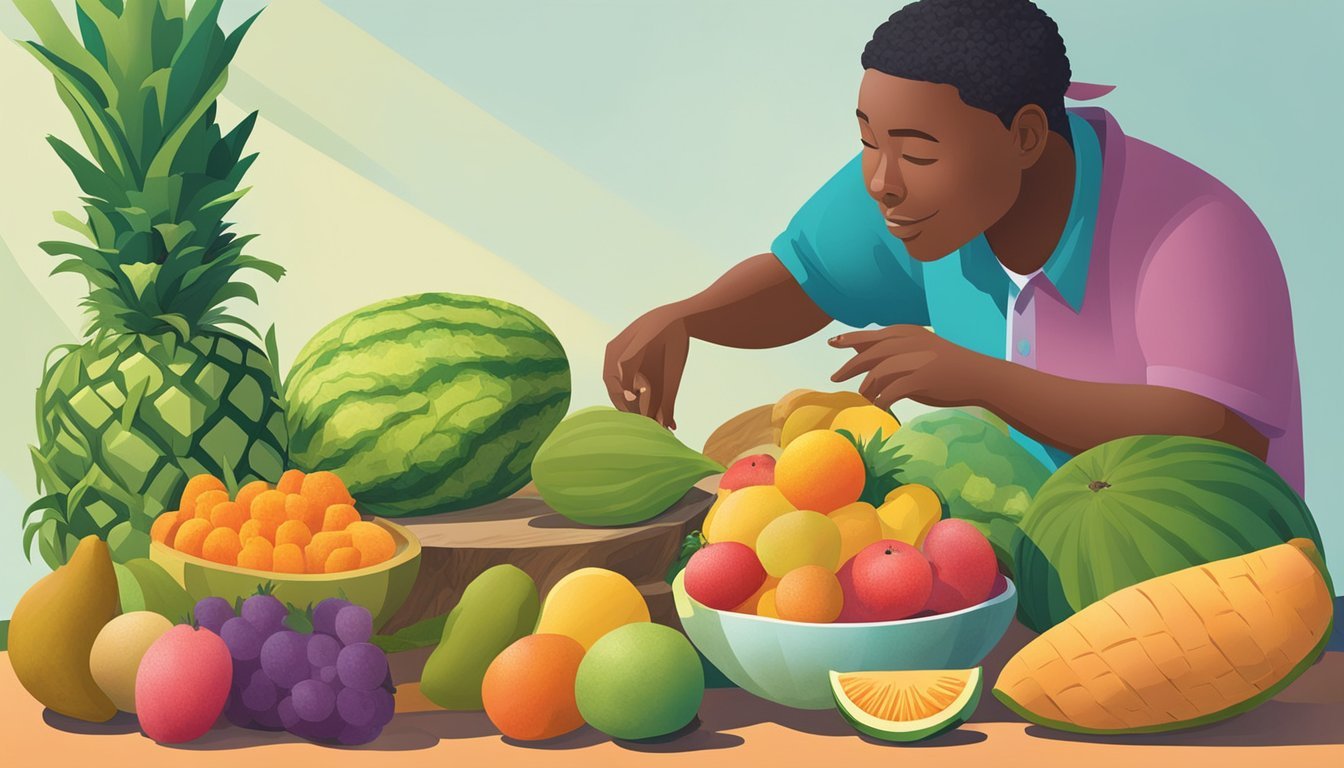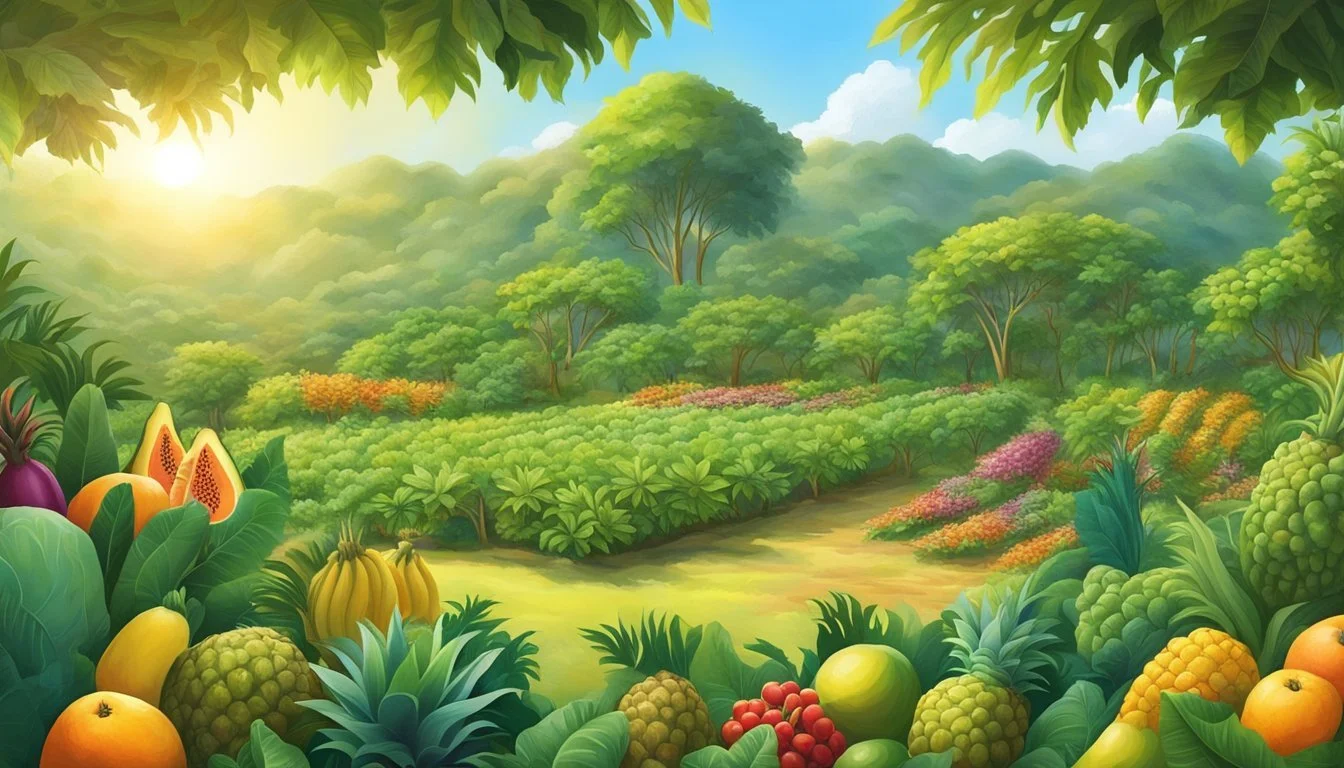Hawaii Seasonal Fruit & Vegetables in February
Your Guide to Fresh Picks
This Article is Part of our Hawaii Seasonal Fruit & Veg Calendar
Hawaii's tropical climate fosters an abundant array of fruits and vegetables year-round, making it an exceptional location for fresh produce. In February, the islands are in the midst of a fruitful season for a range of crops. Visitors and locals alike have the opportunity to enjoy fruits (What wine goes well with fruit?) and vegetables that are at their peak of ripeness during this month.
Some of the standout fruits in February include bananas (how long do bananas last?), avocados, and limes, which are known for their superior flavor and quality when harvested during their peak season. Vegetables like asparagus begin to make an appearance, offering tenderness and freshness unique to the season. Meanwhile, the assortment of produce available in early February is not limited to these few, as the islands' rich soil and favorable weather conditions allow for a continuous growth cycle for many other fruits and veggies. The diversity of Hawaii's agriculture is showcased through its monthly offerings, which are both a reflection of the islands' farming practices and a contributor to its culinary scene.
Hawaii's Unique Agricultural Environment
Hawaii's agricultural richness flourishes due to its unique climate, especially as the winter transitions into spring. The distinct seasonal changes between January and February play a pivotal role in shaping the variety and vitality of the local produce.
The Impact of Hawaiian Climate on Produce
Hawaii's climate is characterized by warm temperatures year-round, ranging from 75 to 85 degrees Fahrenheit, which is ideal for a myriad of fruits and vegetables. The state's diverse microclimates, influenced by its volcanic soil and the surrounding Pacific Ocean, create a nurturing environment for agriculture. In February, the islands' produce benefits from the mild winter conditions. Bittermelons, for instance, thrive during this period due to the favorable temperatures, flourishing from February until June.
Seasonal Shifts: From January to February
As Hawaii moves from January into February, the agricultural environment transitions from the winter harvest towards the onset of spring's bounty. The shift in seasons is subtle due to Hawaii's tropical climate, yet it results in a noticeable change in the local markets.
Fruits: In February, honeydews are in their peak, with a preference for specimens that are round, heavy for their size, and have a creamy yellow hue.
Vegetables: Bittermelon, which peaks from February to June, should be sought after for its freshness and absence of soft or brown spots, especially at the base.
Hawaii's seasonal patterns in February feature a mix of winter and spring produce, reflecting the islands' remarkable capacity to support diverse agricultural products throughout the year.
Fruits of February in Hawaii
February in Hawaii signals a bountiful period for a variety of fruits, ranging from citruses to tropical exotics. This availability enriches the local cuisine and provides ample choice for both residents and visitors.
Citrus and Tropical Delights
Hawaiian fruit producers offer a vibrant selection of citrus fruits during February. These include blood oranges, known for their deep-red flesh and bold flavor, and clementines, with their sweet and easy-to-peel qualities. Grapefruits, kiwis, and lemons are also part of the citrus bounty that winter brings to the islands. Turning to tropical delicacies, February is an opportune time to relish papayas and apple bananas, a small and sweeter variant of the common banana. Although not peak season for all varieties, some mangoes can still be found ripe for enjoyment during this month.
Harvest and Availability of Hawaiian Fruits
The harvest periods for Hawaiian fruits can overlap widely due to the islands' conducive growing environment. Pineapples (how long do apples last?) and bananas are available almost year-round, with February being no exception. Lychee and starfruit may not be in their prime season, yet they can still be found in local markets. For those seeking out the more exotic or less common varieties, like mountain apples or passion fruit, it might require a bit more effort to find them in February. Farmers' markets and specialty stores are good places to check for these fruits, which, when in season, burst with flavor and epitomize the unique profiles of Hawaiian produce.
Vegetables Fresh in February
February in Hawaii showcases a variety of vegetables reaching their peak, with roots and squashes offering hearty flavors and nutritious options, while leafy greens and a spectrum of other vegetables provide both versatility and dense nutritional profiles for the winter meals.
Roots and Squashes
In the cooler months, root vegetables like sweet potatoes (What wine goes well with sweet potatoes?) exhibit their inherent sweetness and are ideal for baking, roasting, or boiling. Kabocha squash is also a notably fresh option available during this time. Known for its hard outer shell, Kabocha stands up well to pests and is a popular choice for its rich texture and flavor.
Sweet Potatoes: Rich, earthy, and versatile for numerous dishes.
Kabocha Squash: Dense and sweet, perfect for roasting or in soups.
Leafy Greens and Other Vegetables
Hawaii is not just about tropical fruits; its range of greens and other vegetables is impressive during February. Cabbage and several varieties of greens are at their best quality, offering crispness for salads and stews. Additionally, staples such as corn, cucumbers, eggplant (What wine goes well with eggplant?), and tomatoes provide the foundation for diverse culinary applications.
Cabbage: Ideal for slaws or fermented dishes.
Corn: Sweet kernels perfect for grilling or boiling.
Cucumbers: Crisp and refreshing, suited for salads.
Eggplant: Great for grilling or as a meat substitute in dishes.
Tomatoes: Juicy and flavorful, excellent for salsas or sauces.
Shopping for Seasonal Produce
In Hawaii, the month of February offers an array of seasonal produce that can be sourced to ensure freshness and support local agriculture. Shoppers have access to vibrant farmers markets and the well-stocked aisles of local grocery stores for their seasonal selections.
Farmers Markets and Local Grocers
Farmers markets in Hawaii are exceptional for finding fresh, local produce. Shoppers looking for the bounties of February should visit various Hawaii farmers market locations where they can purchase directly from the growers. Avocados and bananas, for instance, are in the midst of their harvest season, ensuring ripe, flavorful selections.
Fruits and Vegetables to Look For:
Avocado: November - February
Banana: June - October
Local grocers often feature produce from the seasonal harvest as well, supporting nearby farms. It's an excellent place to find a wide spectrum of locally-grown vegetables, like celery, which, although not in the peak season, is still harvested during this month.
Supermarket Selections
Supermarkets in Hawaii stock up on both local and imported produce. They ensure a consistent supply of fruits and vegetables, even ones that are not currently in season locally. Shoppers might find citrus fruits, such as oranges, which are abundant at this time of the year, alongside more exotic options.
Common Seasonal Produce in Supermarkets:
Avocado: November - February
Orange: Winter months
For shoppers seeking convenience, supermarkets provide a reliable one-stop shopping experience with the trade-off of potentially less local varieties than farmers markets. Shoppers can still make seasonal and locally-conscious choices by checking labels and opting for Hawaiian-grown goods whenever possible.
Preparation and Consumption
When it comes to enjoying Hawaii's seasonal produce in February, proper preparation is key. From the fresh, sweet flavors of the islands' fruit to the hearty, nourishing vegetables, knowing how to consume and preserve these offerings will ensure maximum enjoyment and extended shelf-life.
Fresh Consumption and Cooking Ideas
Fruits:
Bananas: Enjoy fresh and sweet, either eaten as they are or included in desserts.
Papayas: Serve sliced with a squeeze of lemon to enhance their naturally sweet and slightly tart flavor.
Mountain Apples: Consume raw, with their thin outer layer peeled, to experience their juicy and crisp texture.
Vegetables:
Kabocha Squash: Cut into chunks and roast to bring out a delicious, sweet flavor.
Sweet Potatoes: Boil or bake to enjoy their natural sweetness; mash for a creamy side dish.
Cooking Tips:
Use coconut milk to add a rich, tropical flavor to vegetables.
Incorporate fruits into drinks, such as blending papayas with coconut water for a refreshing beverage.
Preservation and Processing of Fruit
Dried Fruit (how long does dried fruit last?):
Bananas: Slice and dehydrate to create chewy banana chips (how long do banana chips last?).
Papayas and Mountain Apples: Cut into strips and dry for a concentrated burst of flavor.
Jams and Jellies:
Use ripe fruits for their natural pectin (how long does pectin last?) and sugars to create jams with a deep, rich color and jelly with proper consistency.
Fruit Type Preservation Method Suggested Use Banana Drying Snacks, cereal toppings Papaya Drying, Jam Desserts, spreads Mountain Apple Drying, Jelly Desserts, glazes for pastries
By utilizing these preparation and preservation techniques, one can indulge in the diverse range of flavors the Hawaii's fruits and vegetables have to offer. Whether consumed fresh or preserved for later use, February's seasonal bounty is sure to bring culinary delight.
Health Benefits of Seasonal Eating
Eating with the seasons offers various health advantages. Incorporating a variety of seasonal fruits and vegetables into one's diet can improve nutritional value, which may enhance overall well-being.
Nutrient-rich: Fruits and vegetables harvested at their peak are often more nutrient-dense. For instance, vitamin C, essential for a healthy immune system, is found in high concentrations in citrus fruits like oranges, which are in season in Hawaii from September to April.
Vitamin C in Seasonal Produce
Oranges: 53.2 mg per 100 g
Lemons: 53 mg per 100 g
These are just a couple of examples showcasing the robust vitamin C content in produce during its peak season.
Diverse Diet: Seasonal eating encourages a varied diet. This is not only more enjoyable for the palate but can reduce the risk of developing chronic diseases by supplying the body with a broad spectrum of nutrients and antioxidants.
Diversity Benefits
Reduces diet monotony
May lower disease risk
Local and Fresh: Consuming locally-grown, seasonal produce ensures that individuals are eating foods that haven’t traveled long distances, potentially decreasing the environmental impact and helping to ensure freshness, which can correlate with higher nutritional quality.
Incorporating seasonal produce like honeydew and citrus fruits during their peak in Hawaii not only enhances flavor but also maximizes the health benefits derived from these foods. By choosing seasonal and local, individuals can support their health with fresh, vitamin-rich options that are ripe for the picking.
Cultural Significance of Local Produce
In Hawaii, local produce is more than a dietary staple; it's a vibrant thread woven into the cultural fabric. The archipelago's unique climate supports a variety of fruits and vegetables that embody the islands' heritage and lifestyle. Hawaiian fruits such as the apple banana, a sweeter and more flavorful cousin to the bananas found on the mainland, or the Hayden and Pirie mangos, provide distinctive flavors that are celebrated throughout the Big Island and beyond.
February marks a period where fruits like avocados are nearing the end of their season, while others such as bananas remain prolific. This offers a snapshot into Hawaii's year-round bounty, which heavily influences the local cuisine. Imported fruits might pale in comparison to Hawaii's home-grown exotic fruits that garner attention for their rich tastes and connection to Hawaiian tradition.
Avocado: November - February
Banana: Year-round, peak June-October
It is within the thriving farmers' markets and family gatherings that the cultural significance of these fruits is most apparent. Consumed daily, they're not only a food source but also a reason for communal pride and a symbol of the land's fertility.
Remarkably, these fruits contribute to the state often regarded as the happiest state in the U.S., possibly owing to the freshest, most nutritious produce available. The dedication to preserving and consuming local produce is a testament to Hawaiians' respect for their land and its gifts. It's this connection that further cements the importance of local fruits and vegetables within the cultural identity of Hawaii.
Supporting Hawaii's Agriculture
Hawaii's agricultural sector thrives when consumers choose locally-sourced produce. By opting for fruits and vegetables grown within the state, individuals directly contribute to the health and sustainability of the local farming industry. February's seasonal offerings include an array of produce that not only supports Hawaii's economy but also reduces the carbon footprint associated with long-distance transportation.
Bitter melon is one of the notable vegetables available during this month. When selecting bitter melon, consumers should look for:
Dark green skin for a milder bitter taste
Yellow skin for a more intensified bitter flavor
Here is a quick summary of how one can support Hawaii’s agriculture:
Purchase Local: Choose fruits and vegetables grown in Hawaii.
Educate Oneself: Learn about Hawaii's peak produce seasons to make informed decisions.
Support Farmers Markets: Visit and buy from local farmers markets.
Emphasizing the promotion of locally-grown food also aids in preserving Hawaii's farmland and spurring innovation in farming practices. It enables local farmers to continue cultivating diverse crops that are suited to Hawaii's unique climate and soil conditions.
Residents and visitors alike can assist in sustaining local food systems by participating in programs and incentives designed to increase the accessibility and affordability of Hawaii’s produce. Such collaborative efforts ensure the vitality of Hawaii's agricultural community and foster a more resilient food network across the islands.









